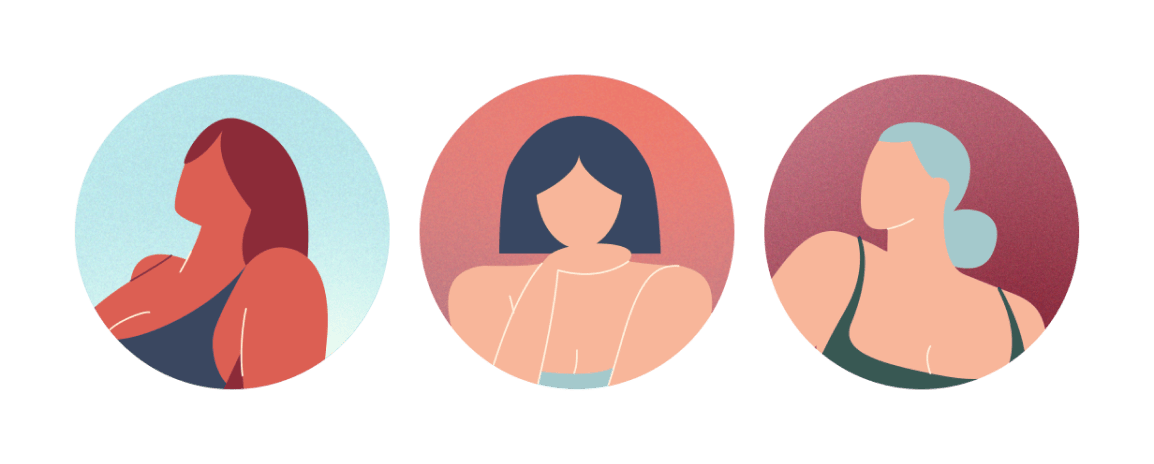
Body
Get to know your body through a better understanding of your anatomy and find the answers to some of your most common questions.

At Mauj, we often talk about the importance of language in shaping our relationship with ourselves and our bodies. While words can sometimes perpetuate shame or stigma, there are other times where their beauty and power must be acknowledged.
How beautiful is it that the Arabic word for womb is derived from the Arabic root for mercy?
The home in which an infant is sown, and its cocoon; closeness, or its origin and causes.
Arabic roots: Empathy and mercy.
This incredible organ, our first home on Earth, is the seat of life, and there is more to it than most of us know. Join us as we take a closer look at our uterus.
The uterus is a pear-shaped muscular organ located in the lower abdomen of your reproductive system. It consists of three main parts: the fundus (top), the body (central portion), and the cervix (lower part). Inside, the uterine wall comprises three layers: the innermost endometrium, the middle myometrium, and the outermost perimetrium.
Additionally, two fallopian tubes extend from either side of the uterus, serving as conduits for eggs to travel from the ovaries to the uterus.
Understanding the different parts of the uterus can help you visualize its structure and better comprehend its functions.
The primary function of the uterus is to provide a nurturing environment for the development of a fertilized egg, leading to pregnancy. However, its function extends beyond pregnancy.
Firstly, the uterus plays a crucial role in the menstrual cycle. Each month, the endometrium, the inner lining of the uterus, thickens in preparation to host a fertilized egg. If fertilization doesn't occur, the thickened lining is shed as menstrual flow. This monthly process is an integral part of the female reproductive system and hormonal balance.
Secondly, the uterus is involved in sexual arousal. During sexual arousal, the uterus lifts upward, which is known as "uterine tenting," creating more space in the vagina. This process can increase sexual comfort and pleasure.
Thirdly, the uterus also plays a role in bone health. Estrogen, a hormone that has a protective effect on bones, is produced in response to the regular changes in the uterus and ovaries during the menstrual cycle. After menopause, when the menstrual cycle stops, estrogen levels drop significantly, leading to an increased risk for osteoporosis.
Lastly, uterine contractions are not just for pushing the baby out during childbirth. They also occur during orgasm, and some researchers believe they help transport sperm from the cervix into the uterus.
So, while the uterus is indeed the organ where pregnancy occurs, its role in the female body is multifaceted and extends beyond just childbearing.
Your uterus and menstruation are closely interconnected, as menstruation is a natural process that occurs as a result of the changes happening within your uterus.
If, in a given month, an egg is not fertilized, you experience a drop in hormonal levels that triggers the shedding of the uterus lining, resulting in menstrual bleeding.
If fertilization does occur, the resulting embryo begins its journey through the fallopian tubes and into the uterus. In the uterus, the embryo seeks a suitable spot to implant itself into the thickened uterine lining, known as the endometrium. The uterus provides a nurturing environment and supplies essential nutrients and oxygen to support the embryo's early development.
Like any other organ, the uterus can be susceptible to various health conditions. Common uterine issues include endometriosis, read more about endometriosis here, fibroids, polyps, and adenomyosis.
As always, it starts with education. Empowering yourself with knowledge about your body can help you make informed decisions about your reproductive health.
We recommend scheduling routine visits with your healthcare provider to undergo pelvic exams, Pap smears, and other screenings as recommended. These exams can help detect any abnormalities or potential issues early on.
Lastly, lifestyle factors significantly impact uterine health. A balanced diet, regular exercise, and maintaining a healthy weight can contribute positively to uterine and overall reproductive health.
Did you find the answer you were looking for? Is there something we missed? What did you think of this resource? We want to hear from you.
